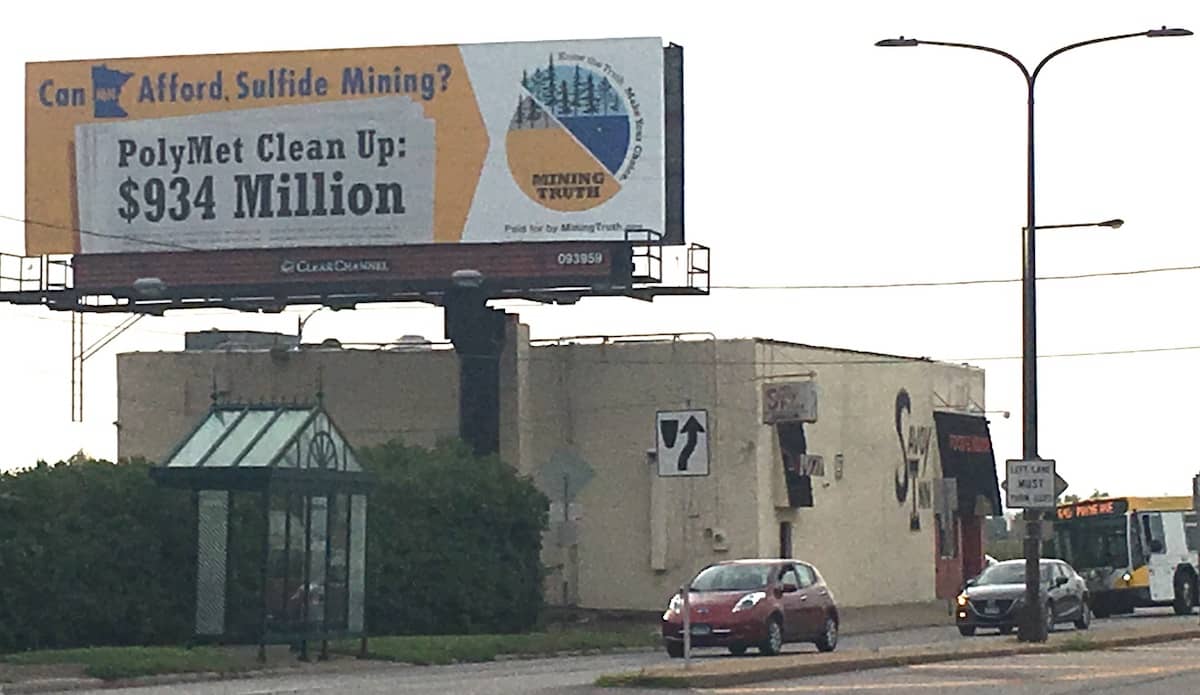
A campaign announced last week with a billboard down the street from the Department of Natural Resources headquarters is seeking to ensure Minnesota receives adequate financial assurance from PolyMet Mining Corp. before the company is allowed to start mining near Hoyt Lakes.
Because extracted copper, nickel and other metals in sulfide ores presents significant risks of water pollution in the St. Louis River headwaters, Mining Truth says clean-up costs could reach $934 million.
The figure is based on a study of the proposal (PDF) by Montana-based mining engineer Jim Kuipers, in which he examined the possibility that water treatment and other mitigation may be required at the site for 500 years after closure.
The coalition of environmental groups called for PolyMet to protect Minnesota from contamination and costly taxpayer-funded clean-ups, even if the company goes bankrupt.
“PolyMet’s own permit application says polluted water from the site will require expensive treatment for decades, if not centuries, after this proposed mine closes” said Kathryn Hoffman, Executive Director of the Minnesota Center for Environmental Advocacy. “Unless Minnesota insists on a bankruptcy-proof, upfront damage deposit, taxpayers could be left with a huge cleanup bill.”
While Kuipers and PolyMet generally agree on how much it would cost to close and fill the mine, he says they have drastically underestimated water treatment costs, overruns, and other factors. While the company anticipates $436 million in closure and treatment costs, Kuipers says the real figure will be twice that.
PolyMet has based its own estimates on 50 years of post-closure treatment, although industry standards are for 100 years or longer. Kuipers looked at the project’s Environmental Impact Statement, which predicts five centuries of water treatment will be needed to prevent pollution. PolyMet’s estimate included cost overruns at 5 percent of the total, while Kuipers says previous examples of mine closures and cleanups had overruns ranging from 30 to 80 percent.
The financial assurance estimates also assume much higher investment returns on funds set aside for closure. The Duluth News Tribune reported last month that Kuipers points out PolyMet is relying on an anticipated 8 percent return, while the federal Office of Management and Budget uses 1.5 percent in its models.
“Using PolyMet’s closing cost estimate but adding in higher cost overruns and lower interest rates, Kuipers said the state should demand at least $514 million and probably much more,” John Myers reported. “Figuring only a 1.5 percent annual return on investment after inflation along with a 30 percent contingency or cost overrun estimate and a 500-year water treatment period, Kuipers says PolyMet should be required to front $934 million before any permit is awarded.”
The DNR and the company are currently engaged in negotiations over financial assurance. The “damage deposit” will likely depend on a plan in which the costs to close and cleanup the mine will change every year, as the mine is developed. It is expected to be most costly eleven years after beginning operations, with the largest amount of backfill needed at that phase.

